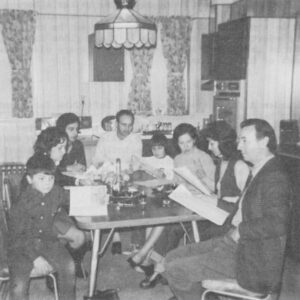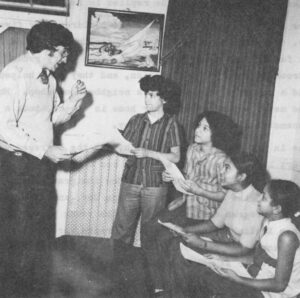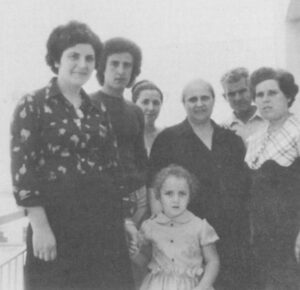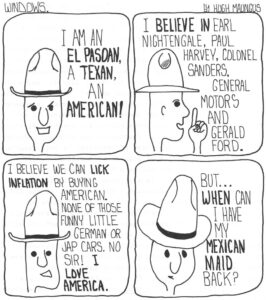MOLA DI BARI, Italy — In this small town on the Adriatic Sea, the main form of recreation for young people is embodied in the phrase passeggiare la piazza — to take a walk in the piazza. Every evening, young men and women come to the town square to enjoy one of the few parentally sanctioned ways of meeting one another. Older men and women come to greet their friends and to keep an eye on what their own and other people’s children are doing. The passeggiata — an old institution with counterparts in most Mediterranean lands — used to be reserved for holidays but became a nightly occasion in the more relaxed social atmosphere that developed after World War Il. It serves both as a link with the past and as a concession to the present by recognizing that young people have the right to choose their own mates, while keeping most of the selection process in the public eye.
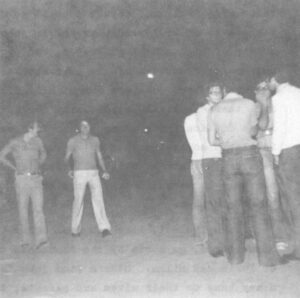 But the passeggiata also symbolizes many of the harsher economic and social realities that force southern Italians to emigrate from their native region and, in many instances, from Italy itself. Many of the young men, and nearly all of the unmarried women, spend their time in the piazza because there is nothing else for them to do. Although the Italian Mezzogiorno benefited from the “economic miracle” of the late Fifties and Sixties, it still lags far behind northern Italy in industrial and commercial development. In prosperous Milan, Turin and Bologna, educated Italians shake their heads and earnestly discuss the problema del Sud (the problem of the South) in much the same manner as white liberals used to discuss the “Negro problem” in the United States. In towns like Mola di Bari, there are simply not enough jobs to go around. The region has a shortage of well-paid blue-collar jobs for the increasing number of high school graduates, and professional jobs for university graduates are in even shorter supply. Many young men who do have jobs are chronically dissatisfied because they feel there is little opportunity for advancement. Because it in so difficult for young men to find satisfactory jobs, there is almost no employment for women: the economic situation reinforces a strong cultural tradition that keeps girls in their parents’ homes until they marry and in their husbands’ homes after marriage.
But the passeggiata also symbolizes many of the harsher economic and social realities that force southern Italians to emigrate from their native region and, in many instances, from Italy itself. Many of the young men, and nearly all of the unmarried women, spend their time in the piazza because there is nothing else for them to do. Although the Italian Mezzogiorno benefited from the “economic miracle” of the late Fifties and Sixties, it still lags far behind northern Italy in industrial and commercial development. In prosperous Milan, Turin and Bologna, educated Italians shake their heads and earnestly discuss the problema del Sud (the problem of the South) in much the same manner as white liberals used to discuss the “Negro problem” in the United States. In towns like Mola di Bari, there are simply not enough jobs to go around. The region has a shortage of well-paid blue-collar jobs for the increasing number of high school graduates, and professional jobs for university graduates are in even shorter supply. Many young men who do have jobs are chronically dissatisfied because they feel there is little opportunity for advancement. Because it in so difficult for young men to find satisfactory jobs, there is almost no employment for women: the economic situation reinforces a strong cultural tradition that keeps girls in their parents’ homes until they marry and in their husbands’ homes after marriage.
Young Molesi, like men from other towns throughout the Mezzogiorno, go north by the thousands to work in the factories of Turin and Milan. Others find jobs in Went Germany and send money home to their wives and parents; they return to Mola for Christmas and summer vacation. No one brings his family to Germany; although the Germans have long used southern Europeans as a source of industrial labor, they ire notoriously inhospitable to the minority of migrant workers who have indicated a desire to settle permanently.
People who want to build a new life in another country generally leave for the United States, where they know that previous generations of immigrants have found a home as well as jobs. Before 1965, immigration from Italy (and from the rest of southern Europe) was sharply limited by a 1924 American law, which maintained a discriminatory system of “national quotas.” Italians who tried to enter the United States under the old system could count on waiting three to fifteen years before their turn came; those without immediate relatives had little hope of receiving immigrant visas within a reasonable period of time. When the new law went into effect, immigration immediately rose from an average of 10,000 a year to its present level of approximately 25,000.
Micele Carlone, a 27-year-old television repairman, is one of many young Mola men who have steady blue-collar jobs but feel they will never “get ahead” in their hometown. He makes 1000 to 1500 lira ($1.55 to $2.30) for a home visit to make a simple repair on a television set. Friends in the United States have told him an American TV repairman makes $15 to $25 for the same work. When I met Carlone in Mola, he was eager to check his friends’ information with a “real American.” I told him American repairmen frequently do make $25 for an hour’s work but warned him that he probably could not expect to earn an American salary until he learned English.
“But of course,” he said with a smile, “You’d have to be a fool not to realize that. Your friends in America only tell you one side of the story, because they want you to come and be with them. But I have already said to myself that the first thing I’ll do in America is learn the language. I think I’m young enough to make a success of this thing. I can go to night school. I don’t have a wife and family, so I’ll have the time to devote to learning. For someone my age, it’s realistic to think I’ll speak English fairly well in six months if I put my mind to it. Then I won’t be confined to Italian-speaking neighborhoods for my work. I know there is a shortage of skilled repairmen in the United States, and I am confident of my skills.”
 | Everyone shops in the open-air mercato in the piazza on Saturdays. |
Carlone hopes to leave Mola within the next six months, but he will not apply for an immigrant visa unless he has a promise of work from an employer in the United States. His friends in Brooklyn are trying to find him a job. If they do not succeed, Carlone plans to use his savings to come to the United States on vacation and look for work himself. “It’s not smart to leave first and look for work later,” he says. “I want to enter America in the category of a skilled workman. Things aren’t so bad here that I would leave, without having any idea of what I will be doing in another country. But I want to go because I feel I can make more progress there (in America). I think here I may be a TV repairman all my life. America, somehow, is more open. You can make more money, save more, get a better education, move up in life.”
Carlone’s comments and attitudes reflect important differences between many of the new immigrants and the impoverished, illiterate peasants who left southern Italy for the United States during the period of massive immigration between 1880 and 1924. The new immigrants are not driven by abject poverty and starvation, as were the people who left the small villages of the Mezzogiorno at the turn of the century. They are literate — usually with high school educations — and they have a reasonably accurate idea of what to expect in the new land. They are able to make a living in Italy but they believe they can do much better — for themselves and their children — in the United States. Says a Mola high school teacher: “The old immigrants — our grandparents — left because nothing could be worse than what they had here. The new immigrants leave because they already have something, but they hope for more than our own country can provide.”
Mola, with a population of approximately 24,000, is located 16 kilometers (10 miles) south of the large port of Bari on the Adriatic. (The two towns lie in the same latitude as Naples.) Bari, which was developed as a port and industrial center by Benito Mussolini, is a fast-growing city of nearly half a million. But Bari cannot provide enough jobs for its own population — or for nearby towns — because it is a magnet for people who are leaving the land throughout the province of Puglia. Molesi, who are close enough to Bari to understand the economic strain created by the continuing migration from poorer regions, do not view a move to the nearest large city as the solution to their own job problems. Nor is Mola a “suburb” of Bari, as a similarly situated American town would be. Like all towns in the Mezzogiorno, Mola has its own dialect, its own food, a distinct way of life that has not been swallowed up by the big city. It is a slow-paced way of life in which the home and family form the center of the universe* A plaque in one new apartment proclaims: “My home is my world*” In the mornings, women clean house, do the daily marketing and prepare the pranzio, the day’s main meal. Men usually work within easy driving or walking distance of their homes, and they return at one o’clock to eat. A few men with demanding jobs return to work after the pranzio, but most take a siesta until four or five in the afternoon. Shops re-open, and most establishments are open for business until eight. In the evening, people stroll in the piazza and gossip. Men gather in bars or social clubs for coffee, a light aperitivo and talk. Women gather on their balconies or around their kitchen tables for coffee, a light aperitivo and talk.
In spite of its employment problems, Mola in a wealthy town by the standards of the Mezzogiorno. The sea has always provided a source of jobs — however dangerous and uncertain — that did not exist in the remote, landlocked villages of Sicily and Calabria. The small harbor is filled with huge deep-water fishing boats that provide their owners with substantial incomes, as well as the small boats of men who make a subsistence living by selling their daily catches in Mola itself. Agriculture is the second largest source of employment, although it is declining in importance as the sons of contadini (peasants) receive more education and refuse to work the land. (In southern Italy, contadinilive in towns — not on the land itself.) The soil and climate near Mola are particularly suited to growing artichokes, which are sold to processors for export abroad as well as for consumption in Italy itself.
The real source of wealth in Mola lies not in the sea or the land but in the town’s long history of immigration to the United States. The Mola city hall has extensive immigration records dating from 1876, when the town was as poor as the rest of the Mezzogiorno. Young men would leave for the United States, save the money they made there and return to buy houses and land in Mola. Some of these men migrated back and forth across the ocean many times, returning to Mola to marry and have children but never bringing their families to settle in the United States. Because a majority of the old Italian immigrants built permanent lives in this country, few Americans realize that a sizeable minority eventually returned to their native land. The back-and-forth migration seems to have been more common in Mola than in most Italian towns, partly because fishermen did not have the fear of ocean voyages that was ingrained in many peasants. Many Molesi did, of course, remain in the United States; it is difficult to find a family in Mola without American relatives. Old women proudly display faded, turn-of-the-century photographs of their men in Alaska, California or Brooklyn. (Many Mola men signed on for fishing expeditions off the California and Alaska coasts; the salmon catch was known to be especially lucrative.) Many old men and women returned to Mola to live on their Social Security and left their children behind in the United States.
Just off the piazza, there is a club for retired men who spent most of their lives in the United States. The walls display pictures of John F. Kennedy, Pope John XXIII, Frank Sinatra and Michael L. Pesce, a 31-year-old New York state assemblyman whose family left Mola when he was 12 years old. Pesce’s father owned a large fishing boat and a house in Mola, but he turned his back on a comfortable life because he was afraid his sons would wind up “walking the piazza” in spite of the advantages he could afford to give them. “The younger people aren’t going to come back the way we did,” says 81-year-old Antonio Ruggiero, who lived more than 50 years in the United States before he returned to Mola to retire on his Social Security and to found the American pensioners’ club. “The young men don’t leave their wives behind the way we did — young people don’t want to live that way. And living in Italy isn’t so cheap anymore. When you came back here after the war, you could live like a king if you’d saved a few thousand dollars from an American salary. No more.”
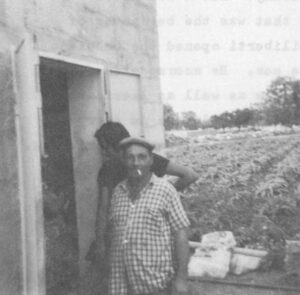 | 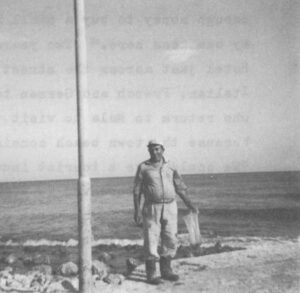 |
| Fishing and farming, the two main sources of work in Mola. | |
For an outsider, an obvious question in why the American money has not generated the kind of development that would create jobs and keep more young people in Mola. The answer lies mainly in the attitudes of the Molesithemselves. “People here just don’t have the idea of using their money to make more money,” says Lorenzo Giliberti, who owns the only hotel in Mola. “They buy a house, land for a little income, clothes and then they put the rest of the money in the bank. Of course this in fine for the people themselves, but it doesn’t make jobs for anyone.” Giliberti jumped ship off the coast of the United States in 1947, when it was virtually impossible for anyone without an American relative to enter the country and when the economic situation in Italy was desperate. He worked in restaurants until 1952, when the U.S. Immigration and Naturalization Service caught up with him. “There was no way for me to legalize my status,” he remembers, “or I doubt that I would ever have come back to Italy. But I had saved enough money to buy a small bar, and that was the beginning of my business here.” Two years ago, Giliberti opened the Gabbiano Hotel just across the street from the sea. He accommodates Italian, French and German tourist groups as well as Americans who return to Mola to visit their relatives. And he is angry because the town beach consists of an unsightly cement outcropping. We could have a tourist industry here,” he says, “but the town just isn’t interested in building one. The water here is very clear compared to the rest of Europe. People who stay in this hotel for one night would stay for a week if there were a developed beach. There would be room for other hotels, some employment for the town. But there isn’t any interest in development, only in saving. Molesi have 13 billion lira deposited in the Bank of Naples alone. Not to mention all of the money in American banks because people don’t trust the Italian government. But it isn’t used to build the kind of town where young people wouldn’t be forced into emigration.”
It is impossible to determine exactly how many Molesi are living in the United States, but the number has increased substantially since the relaxation of the basic American immigration law in 1965. Town records show that 1,277 men and women over 21 are living in the United States, but that figure does not give a true picture of immigration. It only includes people who are registered to vote in Mola. Many immigrants were never registered to vote in Mola. Others migrated to northern Italy before they left for the United States and are not included in the town records. Most Molesi immigrants live in New York City, New Jersey and Chicago. Community leaders in those areas believe there are at least 15,000 first-generation immigrants and their children in the United States.
The impetus for immigration may be increasing as the world economic situation worsens — unless the United States enters an outright depression. Molesi who were staying at the Gabbiano while they visited their relatives were laughing at the constant complaints about inflation in the United States. “I’ve been crying about how much my food bill has gone up,” said one woman from Chicago who left Mola in 1967. “The food is more expensive here than it is in the United States, but the men only make half of what my husband makes. And the women can’t work at all. I make more as a beautician than most of the men do in Mola.” Italy’s inflation rate is one of the highest in Europe, and the grim overall economic statistics have an even more devastating impact on the average consumer. The price of food has risen by more than a third during the past year; fish, meat, eggs and pasta all cost slightly more than they do in the United States. Inflation in the Mezzogiorno is just as bad as it is in the rest of Italy, but salaries are lower and unemployment is higher.
The new immigrants come from all economic classes in Mola. The children of peasants, blue-collar workers and the landowning upper classes are all worried about jobs. “My students talk constantly about the question of emigration,” says Giorgio Del Re, who teaches Latin and Greek at an academic high school where 80 per cent of the students go on to college. (The school is located in Monopoli, a town twice the size of Mola. Mola students who go to academic high schools must arrange their own transportation, because there is no four-year academic school in Mola.) Del Re says his best students usually find places in Italian universities but many others must seek admission at schools in European countries where there are more college places. “The high school students are already aware of the difficulty of finding a job after the university,” says Del Re. “And there is something more. It’s simply a fact that with a shortage of good jobs, the job often goes to the person with a bribe or a connection. It just isn’t as extreme a situation in America. Most of my students are very happy if their parents decide to emigrate. They figure they will get their education in the United States and there will be fewer problems after they finish their schooling.”
Landowning families in Mola frequently marvel at the fact that “anyone” can get an education in modern Italy. However, working-class families frequently perceive the situation differently. They tend to believe — whether they are right or not — that their children are less likely to get into a university than the children of landowners, government officials or professionals. Some parents who would like their children to continue their schooling succumb to their need for an extra income in the family. The children, even more than their parents, perceive class differences as a barrier to their own opportunity.
In Brooklyn, I met two girls who are beat friends. One is the daughter of a carpenter, and she is a freshman at Queens College of the City University of New York. The second girl’s father is a waiter; she will be the first daughter to graduate from high school and she plans to enter college next year. Both girls told me they felt they would never have had the opportunity to go to college in Italy. In Mola, I met both girls’ grandparents and found that the carpenter’s wife’s family occupies a respected position in the upper middle class of the town. The waiter’s daughter, on the other hand, comes from a family where the men have been poor contadini for many generations. The two families did not know each other in Mola.
A woman from one of the town’s best-known, landowning families explained why my two friends had not known each other in Mola. “The one girl comes from a better family than the other,” she said. “I don’t mean they all aren’t good people, but they probably wouldn’t have associated with each other here. And the waiter’s daughter — she wouldn’t go to college in Italy. But that’s the difference between Mola and America. My husband and I lived in America for 13 years before we came back here to take care of my mother. I worked in a clothing factory in Brooklyn. I wouldn’t be thought of well here if I did that. People are more equal there (in America). You work hard, you rise. That’s why Molesi still go to America.”
Received in New York on October 16, 1974.
©1974 Susan Jacoby
Susan Jacoby, a freelance writer, is an Alicia Patterson fellow supported by the Rockefeller Foundation. This article may be published with credit to Mo. Jacoby, the Alicia Patterson Foundation and the Rockefeller Foundation.


